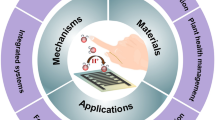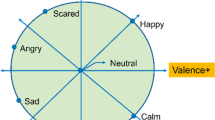Abstract
An ‘affective wearable’ is a wearable system equipped with sensors and tools which enables recognition of its wearer's affective patterns. Affective patterns include expressions of emotion such as a joyful smile, an angry gesture, a strained voice or a change in autonomic nervous system activity such as accelerated heart rate or increasing skin conductivity. This paper describes new applications of affective wearables, and presents a prototype which gathers physiological signals and their annotations from its wearer. Results of preliminary experiments of its performance are reported for a user wearing four different sensors and engaging in several natural activities.
Similar content being viewed by others
References
Hofmann G and Barlow DH. Ambulatory psychophysiological monitoring: a potentially useful tool when treating panic relapse. Cognit and Behav Pract 1996; 3: 53–61.
Goleman D. Emotional Intelligence. Bantam Books, New York, 1995.
Cacioppo JT, Tassinary LG. Inferring psychological significance from physiological signals. Am Psychol 1990; 45(1): 16–28.
Picard RW. Affective Computing. MIT Press, Cambridge, MA, 1997.
Mann S. Wearable computing: a first step toward personal imaging. Computer February 1997; 25–31.
Brown R, Kulik J. Flashbulb memories. Cognition 5: 73–99.
Starner T, Mann S, Rhodes B, Levine J, Healey J, Kirsch D, Picard R and Pentland A. Augmented reality through wearable computing. Presence 1997; 6(4): 386–398.
Lang PJ, Greenwald MK and Bradley MM et al. Looking at pictures: affective, facial, visceral and behavioural reactions. Psychophysiology 1993; 30: 261–273.
Winton WM, Putnam L and Krauss R. Facial and autonomic manifestations of the dimensional structure of emotion. Social Psychol 1984; 20: 195–216.
Levenson RW. Autonomic nervous system differences among emotions. Am Psychol Soc 1992; 3(1): 23–27.
Helander M. Applicability of drivers' electrodermal response to the design of the traffic environment. J Appl Psychol 1978; 63(4): 481–488.
Davidson RJ. Parsing affective space: perspectives from neuropsychology and psychophysiology. Neuropsychology 1993; 7(4): 464–475.
Zimmerman T. Personal area networks {(PAN)}: nearfieldintra-body communication. IBM Syst J 1996; 35: 609–618.
Post R, Reynolds M, Gray M, Paradiso J and Gershenfeld N. Intrabody buses for data and power. In: Proceedings of the IEEE conference The first international symposium on wearable computing, Cambridge, MA, October. 1997. Institute of Electrical and Electronics Engineers.
Author information
Authors and Affiliations
Rights and permissions
About this article
Cite this article
Picard, R.W., Healey, J. Affective wearables. Personal Technologies 1, 231–240 (1997). https://doi.org/10.1007/BF01682026
Issue Date:
DOI: https://doi.org/10.1007/BF01682026




